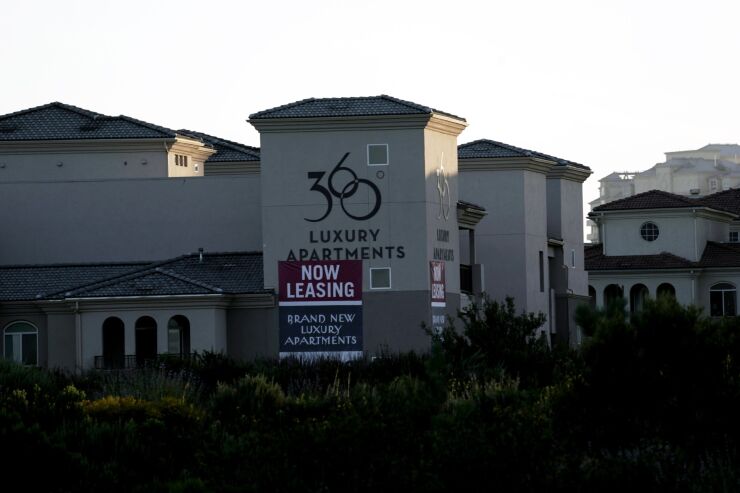
Loans on
Commercial real estate loans for apartment buildings — a category known as multifamily housing — carry their own set of risks, market participants and analysts say, because of the way they're financed as well as recent transaction trends.
"There are a lot of floating-rate loans out there with one- and two-year hedges on them. Once those hedges burn off, rent growth alone won't be able to offset higher servicing costs," said Peter Merrigan, CEO of the real-estate-focused private equity firm Taurus Investment Holdings. "There's a wave of that coming — a big wave."
Floating interest rates are more prevalent among borrowers employing a so-called value-add strategy, in which they aim to sell for a profit within a few years after making basic physical improvements or boosting rental income. These strategies became popular in the multifamily space in recent years as rising household creation and a national housing shortage fostered an appealing supply-demand imbalance for investors.
"Most of the capital in the space has been invested for the long term, but there are some who wanted to turn the property on a three- to five-year horizon," said Robert Pinnegar, president and chief executive of the National Apartment Association. "For those that were looking for a quick flip that happened to purchase an asset at the beginning of COVID and have ridden through this process, it's gonna be more challenging."
With transaction volumes dwindling among higher financing costs and growing economic uncertainty — as well as a disagreement between prospective buyers and sellers on how to revise values accordingly — short-term borrowers are having a hard time selling or recapitalizing assets.
"The issue that we find ourselves faced with is that as rates go up, it's going to impact floating-rate borrowers the most, and those are the borrowers whose typical exit strategy is to sell the property — but there's no transaction happening on the property sales side," said Matt Reidy, director of CRE economics at Moody's Analytics. "This is where we'll see these borrowers tend to get stuck a little bit."
Reidy notes that the issues facing the apartment sector are marginal and more manageable than other parts of the commercial real estate industry. Unlike the office sector, multifamily entered the current period of rising rates riding a wave of multiyear growth in valuations and rents, which serve as cushions against losses. It also is not facing a secular change in demand, as is the case for downtown offices that are still reeling from the shift to remote work.
But borrowers in the multifamily sector tend to start with a smaller margin for error, as loans for apartments are often more leveraged than those for other types of commercial property. Multifamily loan-to-value ratios typically run north of 70%, while office and industrial loans are in the mid-60% range.
Further complicating matters is an influx of competition in the space that has led to a steady decline in annual yields — also known as capitalization rates — delivered to apartment investors in recent years. As capitalization rates remain near record lows and interest rates rise, many owners are seeing their debt-servicing costs outpace their revenue despite rents increasing, albeit at a slower rate than in 2020 and 2021.
Because of this, the clock is ticking on growth-minded borrowers who were expecting a quick and relatively uncomplicated return on their investments, especially as the Fed contemplates further rate hikes.
"If rent growth stays low or flat or takes another leg down, that's definitely an issue for these properties that have borrowing costs that are above their cap rates," Reidy said. "They're definitely going to struggle a lot more with cash flow."
As of March 31, banks collectively held $593 billion of multifamily residential loans on their balance sheets, according to the Federal Deposit Insurance Corp., accounting for roughly 2.5% of assets in the banking system.
Bank lending skyrocketed in the months leading up to the failures in March of Silicon Valley Bank and Signature Bank, the latter being one of the biggest multifamily lenders in New York at the time of its demise. Between February 2022 and February 2023, banks added $121 billion of multifamily debt, according to Federal Reserve data analyzed by the real estate brokerage Newmark — roughly triple the typical annual growth rate.
Reidy said multifamily lending is spread throughout the banking system. While large banks hold the bulk of total assets because of the concentration of large loans on their books, most of the transaction volume is driven by regional banks, many of which are under pressure in the wake of this spring's banking crisis.
Some in the multifamily space hope the sector's issues resolve on their own, either by the Fed lowering interest rates or rent growth picking up to offset higher costs. Merrigan also noted that he and other asset managers are raising funds to recapitalize well-performing apartments that are under financial duress.
"There's a lot of money being formed to deleverage assets and buy them some time," he said. "The way things get better is not operationally, because that part of the business is already fine. It's through a reduction of the yield curve."
Yet, if rates do remain high for an extended period, Pinnegar worries the financing issues faced by multifamily owners — which also include rising operational costs, taxes and insurance premiums — will be overlooked by banks because of their focus on the office sector.
"The distress on the commercial office side is taking a lot of the air out of the room right now. That is the focus," he said. "The expectation is there will be a lot of 'extend and pretend,' because banks aren't interested in wholesale foreclosures in the commercial office space, but that strategy takes capital out of the market that could be loaned on other commercial real estate — like multifamily."




